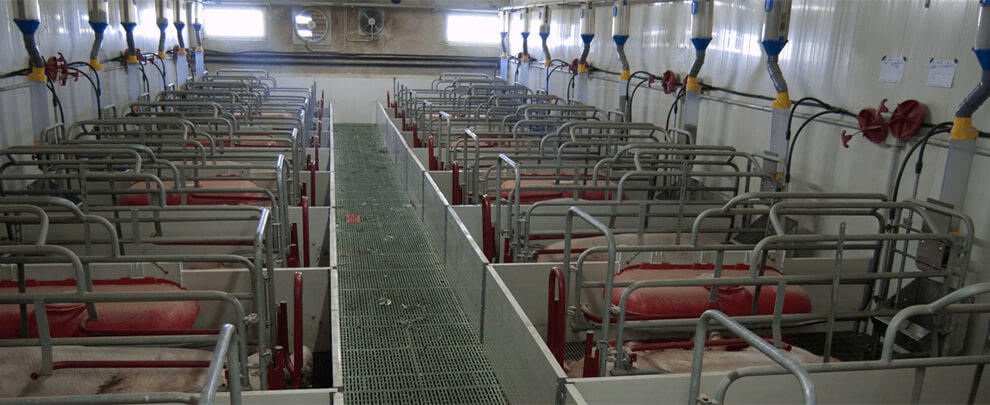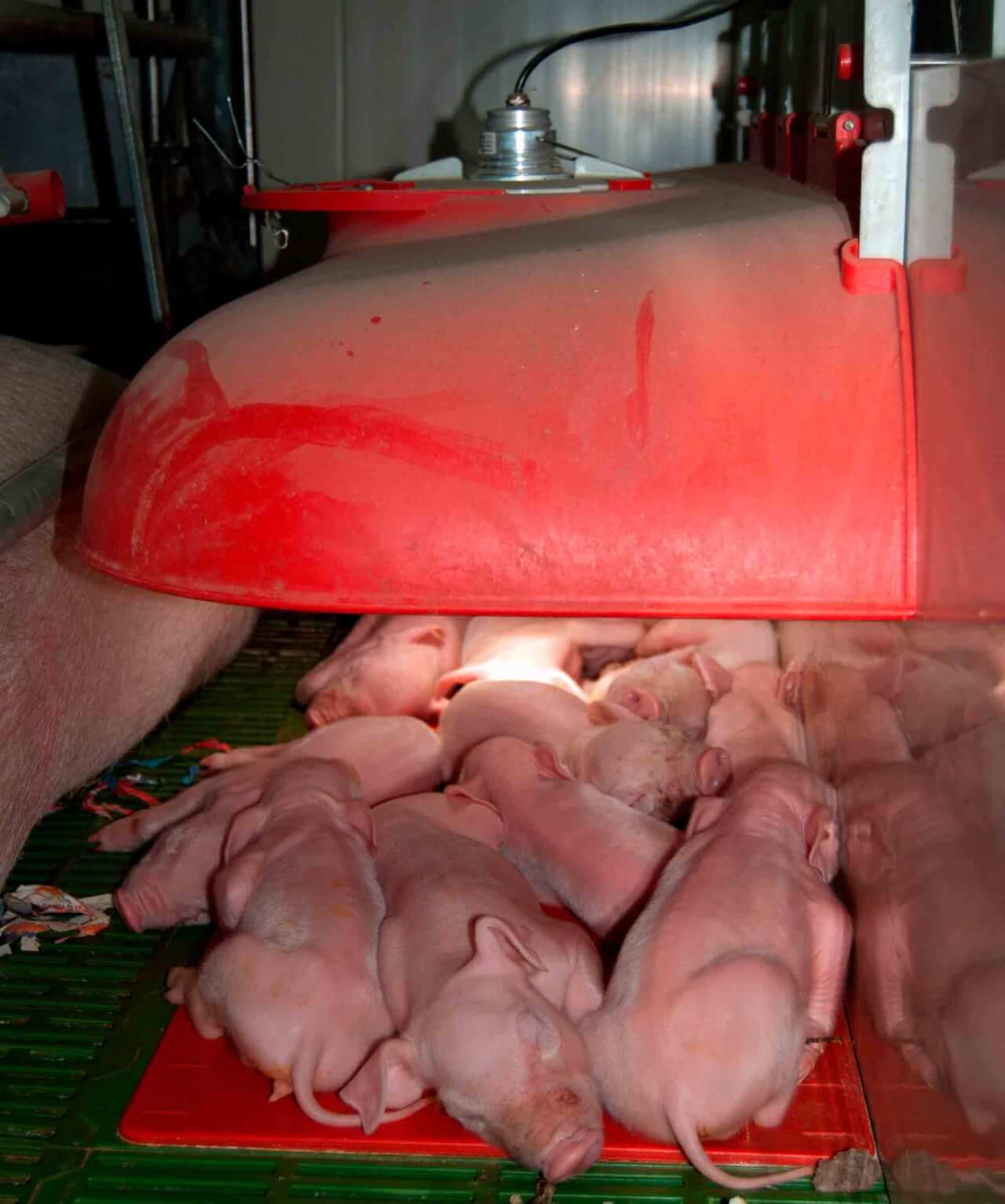Blog
Blog

Analysis of energy savings in farrowing
29th August 2018 - Studies
Carme Soldevila. Agricultural Engineer, Rotecna.
Piglets remain in the sow’s uterus at a stable temperature of 39–40 ºC. At birth, the piglet finds itself in conditions that make it very sensitive to drafts and low temperatures. They are born wet and with little skin insulation due to their low amount of hair and fat. These newborns have very few energy reserves at the start of their lives and must expend energy to reach a teat to obtain colostrum, their first source of calories. All these factors result in all piglets losing temperature during the first half hour of life. For this reason, it is not only important to have good insulating materials, such as plastic in the facilities or paper provided during farrowing, but it is essential for piglets to have a localized heat source that provides them with the thermal comfort they need (about 35 ºC at birth), while not compromising the cooler environment that sows require for their well-being (18–20 ºC).
The use of Rotecna’s Ni-2 in farrowing rooms provides piglets with an optimal environment throughout the year. In the hottest months, the Ni-2 protects piglets from drafts generated by cooling panels, which work at maximum capacity to reduce temperatures in the farrowing rooms. During the colder months, the Ni-2 creates a warm microclimate for the piglets by concentrating the heat provided by the heating plates and/or lamps. This ensures that the generated heat is concentrated in a limited space for the piglets without needing to increase the ambient temperature of the room. This approach leads to energy savings in heating ranging from 30% to 40%, depending on the management system used in the farrowing rooms.
Farm Test
To verify these figures, a test was conducted on a commercial piglet production farm with around 1,950 productive sows, Binapig, in the province of Huesca. The test took place in two farrowing rooms, each with 20 pens, and each pen had two Rotecna electric heating plates (600x400 mm, 70 W) as the only heat source. In one room (control), the existing temperature management system was maintained, with a weekly decreasing regime for the surface temperature of the plates (35 ºC, 33 ºC, and 29 ºC) and the ambient temperature (24 ºC, 23 ºC, and 22 ºC). In the other room (Ni-2), Rotecna’s mobile Ni-2 units were installed 40 cm above the heating plates. The ambient temperature regime from the control room was maintained, and the surface temperature of the plates was slightly reduced (by 1 ºC or 2 ºC) compared to the control room’s reference values. Two replicates were performed with a 1 ºC reduction and three replicates with a 2 ºC reduction in plate temperature, always ensuring that the microclimate temperature was equal to or higher than that of the control room, and that piglet behavior indicated thermal comfort. Ambient and microclimate temperatures (approximately 15 cm above the floor, above the plate) were recorded in both rooms, and daily electricity consumption for heating was measured per room. Additionally, piglet mortality and average daily gain were assessed, although there was some piglet movement between pens.

Piglets in Rotecna's Ni-2 Mobile with led. Photo: Rotecna.
In the first test, the use of Rotecna’s mobile Ni-2 allowed for more than 28% energy savings throughout the lactation period (from 0.95 kWh/pen/day in the control room to 0.68 kWh/pen/day in the Ni-2 room). With this temperature pattern, approximately 55% of consumption occurred during the first week, when piglet temperature needs are highest and body heat contribution is low; the second week accounted for about 35% of consumption, and the last week only 10%. Despite reducing the surface temperature by one degree, using the Ni-2 achieved 2.4 ºC higher microclimate temperatures (28 ºC vs. 25.6 ºC in the control room), with no differences in ambient temperature. In terms of piglet performance, no differences in weight gain were observed, but there was lower mortality in the Ni-2 room.
As the results of the 1 ºC reduction were favorable in all aspects, a 2 ºC reduction was tested. Results remained positive, with an average energy saving of 31% (from 0.86 kWh/pen/day in the control room to 0.59 kWh/pen/day in the Ni-2 room). Despite the 2 ºC reduction in plate surface temperature, the Ni-2 units achieved 1.7 ºC higher microclimate temperatures and slightly improved performance: lower piglet mortality and greater weight gain.
Considering the average consumption across both tests, a heating saving of approximately 30% was achieved. On the farm where the test was carried out:
- Number of productive sows: 1,950
- Lactation duration: 22 days
- Farrowing pens: 380
- Days of heating per year: 301
- Electricity price: €0.098/kWh
The energy savings totaled €2,919 annually. However, the savings could be increased further by turning off the plates during the final days of lactation in the warmer months or by attempting to reduce the temperature even more, as a 2 ºC surface reduction still yielded nearly 2 ºC more microclimate temperature in the Ni-2 room compared to the control. But the benefits are not only in energy savings — they also stem from improved piglet performance. Although only a few replicates were performed, results showed improved weight gain and, more notably, reduced mortality — by 7.6% (from 11.8% to 10.9%) up to 29.4% (from 13.6% to 9.6%). Every 1.5% absolute reduction in mortality, in a farm like this with 1,950 sows, means about 938 more weaned piglets per year. Therefore, assuming an average production cost of €29/weaned piglet, the use of Ni-2 brings a productivity benefit of over €27,000 annually. Under these conditions, the Ni-2 units pay for themselves in six months, after which energy savings and improved productivity translate into net gains.
In conclusion, the use of Rotecna’s Ni-2 in farrowing rooms enables, on one hand, energy savings exceeding 30%, and on the other, improved piglet productivity indicators, with reduced mortality and slightly increased weaning weights. In a farm like the one tested, with 1,950 productive sows, the minimum estimated energy saving with Ni-2 is about €2,900/year, to which an estimated benefit of more than €27,000/year from reduced mortality must be added (assuming a 1.5% absolute reduction). The total savings mean the nests pay for themselves in about six months. However, savings could be optimized further by switching off the plates during the last week of lactation in summer or even lowering the target plate temperature by another degree.






